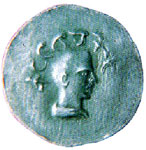| Kuttuvan Kotai | |
|---|---|
 Kuttuvan Kotai. Legend in Tamil-Brahmi: "Ku-t-tu-va-n Ko-tai" | |
| House | Chera dynasty |
Kuttuvan Kotai (Tamil: குட்டுவன் கோதை), also spelled Kothai/Kodai,[1] was a Chera ruler of early historic (pre-Pallava) south India.[2][3]
Silver coins bearing a portrait facing right with Tamil-Brahmi legend "Ku-t-tu-va-n Ko-tai" have been discovered from Amaravati riverbed in Karur, central Tamil Nadu.[4][3][5] The reverse of the coins are blank. The coin seems to be an imitation of the Roman portrait head coins.[5] Whether these coins were used as a currency in trade transactions is not clear.[2]
Scholars identify Kotai with "Cheraman Kuttuvan Kotai" mentioned in the early Tamil text Purananuru, 54.[5] This Chera is mentioned as Kotai, not as Kuttuvan Kotai, in the body of the poem, but the appended colophon gives the full name "Kuttuvan Kotai".[5][1] The Chera is eulogized in the Puram by Konattu Ericchalur Matalur/Matalan Madurai Kumarananar (Purananuru).[1] The son of Chera ruler Cenkuttuvan was also referred to as "Kuttuvan Cheral".[1]
Kuttuvan was probably an ancient title for the Chera rulers of south India. Early Tamil texts refer to "Kuttuvar" as a kingship group and "Kuttanatu" as the country of the Kuttuva people.[6] The term Kuttanatu is indicated in the entry in Periplus Maris Erythraei, referring to "Cottonora", ‘where the pepper grows’.[6] The estuarine region Kottayam and Alappuzha districts of Kerala is now known as Kuttanatu.[6]
- ^ a b c d Aiyar, K. G. Sesha (1937). Chera Kings of the Sangam Period. London: Luzac and Co. pp. 53–54.
- ^ a b Rajan, K. (2011), "Emergence of Early Historic Trade in Peninsular India", Early Interactions between South and Southeast Asia: Reflections on Cross-Cultural Exchange, ISEAS–Yusof Ishak Institute, pp. 182–183, ISBN 978-981-4311-17-5
- ^ a b Champakalakshmi, R. (1996). Trade, Ideology, and Urbanization: South India 300 BC to AD 1300. Oxford University Press. pp. 111 and 137.
- ^ Mahadevan, Iravatham (2003). Early Tamil Epigraphy: From the Earliest Times to the Sixth Centuy AD. Harvard Oriental Series. Cre-A and Harvard University. pp. 117–119 and 62–63.
- ^ a b c d Majumdar, Susmita Basu (2017). "Money Matters: Indigenous and Foreign Coins in the Malabar Coast". In Mathew, K. S. (ed.). Imperial Rome, Indian Ocean Regions and Muziris: New Perspectives on Maritime Trade. Routledge. pp. 410–411.
- ^ a b c Ganesh, K. N. (2009). "Historical Geography of Natu in South India with Special Reference to Kerala". Indian Historical Review. 36 (1): 3–21. doi:10.1177/037698360903600102.
